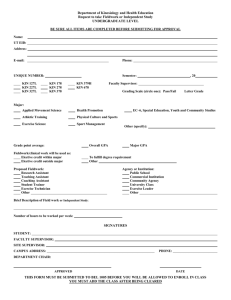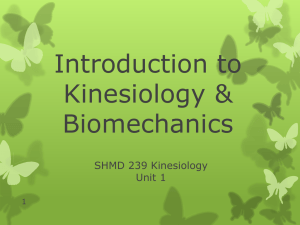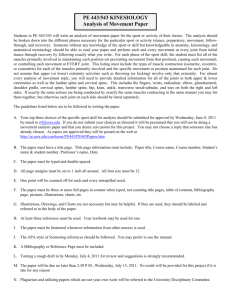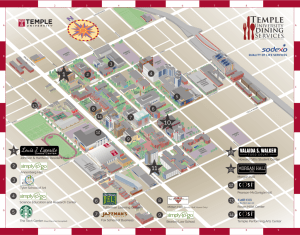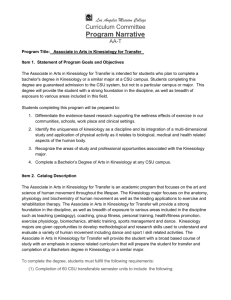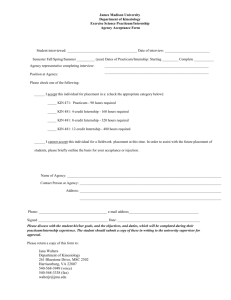American Kinesiology Association
advertisement
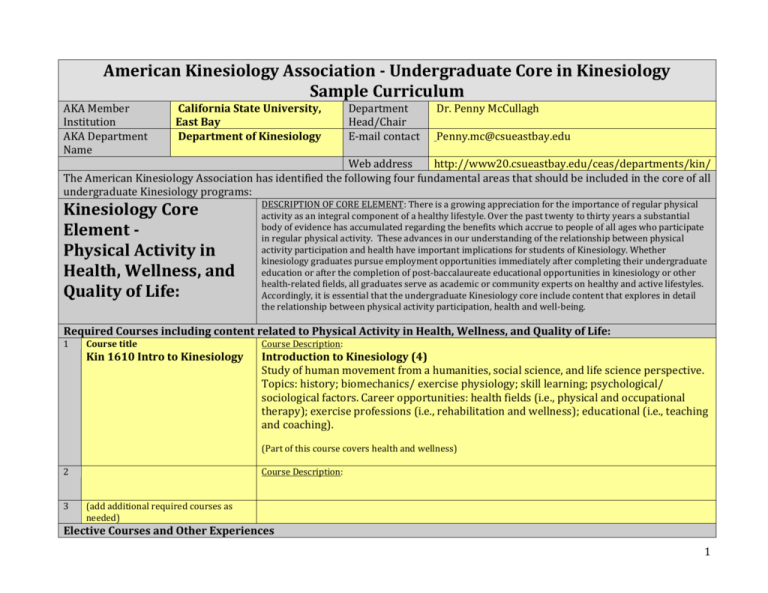
American Kinesiology Association - Undergraduate Core in Kinesiology Sample Curriculum AKA Member Institution AKA Department Name California State University, East Bay Department of Kinesiology Department Head/Chair E-mail contact Dr. Penny McCullagh Penny.mc@csueastbay.edu Web address http://www20.csueastbay.edu/ceas/departments/kin/ The American Kinesiology Association has identified the following four fundamental areas that should be included in the core of all undergraduate Kinesiology programs: Kinesiology Core Element Physical Activity in Health, Wellness, and Quality of Life: DESCRIPTION OF CORE ELEMENT: There is a growing appreciation for the importance of regular physical activity as an integral component of a healthy lifestyle. Over the past twenty to thirty years a substantial body of evidence has accumulated regarding the benefits which accrue to people of all ages who participate in regular physical activity. These advances in our understanding of the relationship between physical activity participation and health have important implications for students of Kinesiology. Whether kinesiology graduates pursue employment opportunities immediately after completing their undergraduate education or after the completion of post-baccalaureate educational opportunities in kinesiology or other health-related fields, all graduates serve as academic or community experts on healthy and active lifestyles. Accordingly, it is essential that the undergraduate Kinesiology core include content that explores in detail the relationship between physical activity participation, health and well-being. Required Courses including content related to Physical Activity in Health, Wellness, and Quality of Life: 1 Course title Kin 1610 Intro to Kinesiology Course Description: Introduction to Kinesiology (4) Study of human movement from a humanities, social science, and life science perspective. Topics: history; biomechanics/ exercise physiology; skill learning; psychological/ sociological factors. Career opportunities: health fields (i.e., physical and occupational therapy); exercise professions (i.e., rehabilitation and wellness); educational (i.e., teaching and coaching). (Part of this course covers health and wellness) 2 3 Course Description: (add additional required courses as needed) Elective Courses and Other Experiences 1 Kin 4614 – Exercise and WellBeing Kin 4615 Exercise and Stress Exercise and Well-Being (4) The nature of physical activity in relationship to fitness, health, and wellbeing. Understanding stress and the prevention of diseases related to stress and inactive lifestyles. Prerequisite: Upper division standing. Not for KIN major or minor credit. Exercise and Stress (4) The nature of stress and its relationship to exercise. The physiology of the stress response, its role in disease, and immediate and long term interactions of exercise and stress. Prerequisite: PSYC 1000 highly recommended. 2 Kinesiology Core Element Scientific Foundations of Physical Activity: DESCRIPTION OF CORE ELEMENT: A defining feature of the academic discipline of Kinesiology is its embrace and integration of the multi dimensional study and application of physical activity. Well-prepared Kinesiologists are expected to have a sound understanding of the scientific foundations of physical activity. For many departments this scientific foundation is provided by a series of courses that are taken by all majors regardless of their ultimate career goals. Examples of scientific foundation courses include exercise physiology, motor behavior, biomechanics, sport and society, and exercise psychology. The specific titles and content of scientific foundation courses offered will vary from institution to institution depending on local preferences and constraints. Required Courses including content related to the Scientific Foundations of Physical Activity: 1 Course Title Biology 2010 Human Physiology and Anatomy 2 Kin 3300 Measurement and Evaluation 3 4 5 Kin 3305 Structural Kinesiology Kin 3310 Biomechanics Kin 3320 Exercise Physiology Course Description: Human Physiology and Anatomy I (5) An integrated approach to essential concepts of human physiology and anatomy. Analysis of skeletal, muscular, sensorimotor, cardiovascular and respiratory systems. Recommended preparation: high school biology and chemistry, or BIOL 1001 (or 1005) and BIOL 1002; CHEM 1100 or 1601 (or 1605). Not open to students with credit for BIOL 2011. Not for Biology B.S. degree credit. Four hrs. lect., 3 hrs. lab. Measurement and Evaluation (5) Theory and application of measurement and assessment procedures related to physical activity. STAT 1000 highly recommended. Four hrs. lect., 3 hrs. lab. Structural Kinesiology (4) Anatomical structures as functional determinants of movement. Skeletal, muscular, and nervous systems and their roles in determining movement efficiency. Kinesiological application of anatomical information. Recommended preparation: BIOL 1001 and CHEM 1100 or equivalents. Prerequisite: BIOL 2010 or 2011. Not open to students with credit for KIN 3331. A-F grading only. Biomechanics (5) Biomechanics of human movement and the mechanical and muscular analysis of movement patterns. Prerequisites: BIOL 2010 (or 2011); KIN 3300, KIN 3305. Four hrs. lect., 3 hrs. lab. Exercise Physiology (5) The physiological parameters and mechanisms that determine adaptations of the physiological systems of human beings in response to exercise. 3 6 Kin 3330 Motor Learning and Control 7 Kin 3340 Motor Development 8 Kin 3350 Sport and Exercise Psychology Prerequisites: BIOL 2010 (or 2011); KIN 3300, KIN 3305. Four hrs. lect., 3 hrs. lab. Motor Learning and Control (5) The nature of sensorimotor skills. Analysis of the motor systems and mechanisms of basic sensorimotor integration. An overview of skill acquisition related primarily to sport and exercise. Prerequisites: BIOL 2010 (or 2011); KIN 3300, KIN 3305. Four hrs. lect., 3 hrs. lab. Motor Development (4) Theoretical perspectives relevant in motor development research. Physical growth and maturation process from infancy to old age, including development and aging effects of specific body systems. Relevant social, cultural, psychosocial, and cognitive influences on human movement across the life span. Prerequisites: KIN 3300 and KIN 3305. A-F grading only. Sport and Exercise Psychology (5) Theoretical and practical application of psychological factors in sport, exercise, rehabilitation and other physical activity settings. Topics include: motivation, anxiety, observational, learning, imagery, exercise adherence, injury and youth sport participation. Prerequisite: KIN 3300 with at least a grade of C. A-F grading only. Four hrs. lect., 3 hrs. lab. (add additional required courses as needed) Elective Courses and Other Experiences: Kin 3205– Mental Skills for Performance Kin 3210– Science of Expertise Mental Skills for Performance (4) Mental skills for performance; reviews theory and then provides practical examples of mental skills that can be used in a variety of settings. Topics include: mental imagery, arousal control and self-efficacy, and concentration on video training. A-F grading only Science of Expertise (4) Examination of research based evidence on the nature of expertise. The evidence will challenge commonly held beliefs that talent is innate and will, instead, review the literature that supports that motivation, dedicated practice and environment are major contributors. A-F grading only. 4 Kinesiology Core Element - Cultural, Historical and Philosophical Dimensions of Physical Activity: DESCRIPTION OF CORE ELEMENT: A solid grounding in cultural, historical and philosophical aspects of kinesiology is an essential component of a Kinesiology education. Sociocultural and historical factors influence attitudes about and practices of physical activity. This is true for both the individual and the communities in which they live. In addition, an understanding of philosophical and historical issues will help prepare future professionals for the numerous ethical questions they will face upon graduation. Coursework in the humanities assists the student to understand and appreciate diversity, to develop cultural competencies, and to make ethical decisions based on sound principles. In many Kinesiology departments, undergraduate coursework examines topics related to physical culture, cultural kinesiology, sociology of sport and physical activity, history of sport and physical activity, and sport marketing and media. Specific courses will vary from institution to institution depending on local preferences and constraints. Required Courses including content related to the Cultural, Historical and Philosophical Dimensions of Physical Activity: 1 2 Course Title Kin 3700 History of Sport and Physical Education Kin 3740 Philosophical Foundations of Kinesiology Course Description: History of Sport and Physical Education (4) Examination of the history of sport and physical education in the United States from the early 19th century to the present with emphasis on the interplay between sport, social institutions and identity. Prerequisite: junior standing. Course Description: Philosophical Foundations of Kinesiology (4) Examination of the various ontological, epistemological, and axiological issues in sport with particular attention given to how conceptualizations of embodiment and ethical issues impact sport, physical education, and movement. 3 Kin 3750 Sport in Contemporary Society Sport in Contemporary Society (4) Examination of sport as a significant social and cultural institution that impacts and is impacted by the larger society. It analyzes past and contemporary issues and controversies through various sociological frameworks. Recommended preparation: SOC 1000 (or one of 1002). Elective Courses and Other Experiences: 5 Kin 3200 Sport and Film: Cultural Perspectives Kin 3735 Sport, Racism, and Ethnicity Sport in Film: Cultural Perspectives (4) Societal values, politics, mores, and individual and group behavior related to sport participation as illustrated in film. Sport, Racism, and Ethnicity (4) Examines sport as a cultural site that reproduces and challenges racial and ethnic inequalities and ideologies. Prerequisite: Upper Division Standing. Not open to students with credit for ES 3140. 6 Kinesiology Core Element The Practice of Physical Activity: DESCRIPTION OF CORE ELEMENT: The AKA believes that regular participation in physical activity is an essential component of a healthy and successful lifestyle and that the undergraduate curriculum should provide numerous opportunities for students to be physically active. For example, opportunities may come from a physical activity skills program that allows for participation in sport and recreation through a diverse menu of courses taken for academic credit. Alternatively, students may be encouraged to be physically active through internship and practicum experiences. In other instances physical activity participation may occur at venues outside the Kinesiology department, such as in campus recreation facilities. While the AKA strongly supports students being physically active, it does not prescribe a specific process for departments to follow regarding how the practice of physical activity is incorporated into the curriculum, but staunchly supports curricular or extra-curricular physical activity experiences for individual and group participation. Required Courses including content related to the Practice of Physical Activity 1 2 Course Title Kin – Activities (5 units required one in each category – one unit each course). (add additional required courses as needed) Course Description: Swimming, Combatives, team sports, Individual or dual fitness activities Elective Courses and Other Experiences: 2 Course title: Course Description:. 3 4 5 6 7 8 (add additional courses/experiences as needed) 7 8
